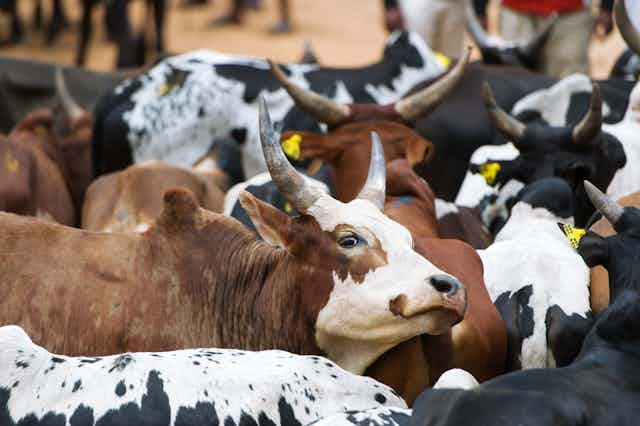Meat and animal products are important sources of protein. They are also a delicacy in most meals in Africa. But they can also be potentially hazardous. While most Africans relish meat, proper meat inspection has eluded the continent for decades.
Meat inspection is the process that monitors the slaughtering of animals. It is done by a veterinary doctor and meat inspection officers at accredited abattoirs. They work together to ensure that ill animals are separated from healthy animals.
Recent research has shown meat inspection practices in most developing nations are inadequate and that meat is becoming a major source of microbes, parasites and heavy metals.
Ineffective meat inspection increases the possibility of someone contracting food- borne neglected tropical diseases like trematode infection, taeniasis, cysticercosis, and toxoplasmosis. The effects of these diseases ranges from mild symptoms such as diarrhoea to severe conditions such as epilepsy (which can develop from cysticercosis and taeniasis) as well as stillbirths and miscarriages, which can result from toxoplasmosis.
Ineffective meat inspection has also been shown to contribute towards the emergence of “superbugs” that are resistant to most antibiotics and the accumulation of “heavy metals” which are harmful to our health.
This means it’s hugely important to upgrade existing meat inspection practices and improve public education.
Why meat needs inspection
Internationally, meat inspection procedures are guided jointly by the Food and Agriculture Organisation and the World Health Organisation through international food standards. Its meat inspection programme has two main objectives:
to make sure that, before animals are slaughtered, abnormal ones are dealt with separately from healthy, physiologically normal ones; and,
to ensure that meat from animals is free from disease, is wholesome and carries no risk to human health.
But many developing countries do not adhere to the Food and Agriculture Organisation’s meat inspection guidelines and do not have enough meat inspection officers.
This has led to a rise in various food borne diseases. An international workshop on the issue found that many developing countries were failing to fully implement their own meat inspection laws and regulations and that they lacked well-established and structured slaughtering facilities.
This is supported by evidence gathered in Nigeria and research done in Ethiopia.
In Oyo state in a Nigeria, which has a population of 5.5 million people, I found that there were fewer than 30 veterinary officers in charge of meat inspection and that the abattoirs were in a despicable state.
Similarly, a study done in eastern Ethiopia found that more than 60% of the people interviewed had been infected with cysticercosis once in the year before the study. Of these, 99% had eaten raw or under-cooked beef. Of the 898 local zebu cattle slaughtered for human consumption nearly 20% harboured at least one cyst in the animals’ shoulder muscles, liver and hearts. All these cuts are preferred by local people to prepare and eat as raw or inadequately cooked meat dishes.
Heavy metals in meat
Adequate meat inspection also ensures that there is not an oversupply of “heavy metals” in food.
The right amount of metals such as iron, copper, zinc and manganese in foods are important. Essential minerals play a role in our bodies functioning efficiently.
But there are several “heavy metals” which could be hazardous if they are found in the body, even at low levels. These include lead, cadmium and mercury. They can have varying health effects and have been found to cause cancers, kidney damage and damage to the nervous system.
Several studies have shown how heavy metals find their way into the food chain in various parts of Africa. These were found in higher doses than recommended.
One study found a high concentration of heavy metals in poultry and beef in regions of Nigeria.
Superbugs and meat inspection
Superbugs are an emerging group of bacteria that are resistant to several types of antibiotics. In selected cases they have severely crippled established health systems. In one case in the UK, an intensive care unit had to be closed down after people died from a superbug.
In South Africa, microbiologists reported that the emergence of superbugs meant only a limited range of antibiotics were available to treat infected patients.
Research shows that while some superbugs evolve as a result of antibiotic misuse, others are the result of superbugs being transferred from eating and handling meat contaminated with resistant bacteria. One study identified multidrug resistant bugs in food animals. These provide the transmission link of the superbug from animals to humans.
A realistic solution to this would be to demand that veterinarians are more involved in overseeing the use of antibiotics on farms.
Alternatively, it would be a good move to set up a system that could track and report resistance during food inspection within each country. Both the US and Denmark have done this. In both instances government departments and public health officials work together to track resistance to antibiotics and ensure that safe foods are delivered to the public.
The way forward
Most African nations have various food and drug regulatory agencies. But the local meat industry has been neglected. This needs to change.
In the absence of improved meat inspection practises there are initiatives that citizens can implement themselves. The preparation of their food and meat is one. A study in Senegal highlighted how certain cooking methods reduce the risk of transmission of food borne pathogens.
Most traditional West African meat dishes involve a combination of boiling, frying and cooking in sauces at boiling temperature for at least 30 minutes. These stages can help remove superbugs and parasites that cause most neglected tropical diseases.
Ultimately in the long run, however, the onus lies with governments. Their responsibility is to implement meat inspection legislation and to adequately monitor livestock activities from the farm to the fork with oversight by veterinarians. In addition, they need to create laboratories that are responsible for regular testing and monitoring meat. This will that ensure safe food is delivered and reliable approaches to prevent diseases are in place.

